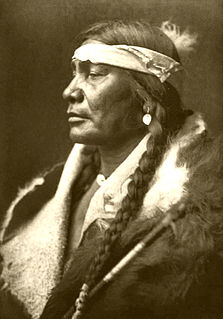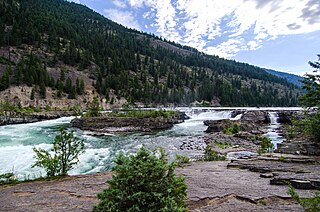 W
WThe Assiniboine or Assiniboin people, also known as the Hohe and known by the endonym Nakota, are a First Nations/Native American people originally from the Northern Great Plains of North America.
 W
WThe Blackfoot Confederacy, Niitsitapi or Siksikaitsitapi, is a historic collective name for linguistically related groups that make up the Blackfoot or Blackfeet people: the Siksika ("Blackfoot"), the Kainai or Kainah ("Blood"), and two sections of the Piikani – the Northern Piikani (Aapátohsipikáni) and the Southern Piikani. Broader definitions include groups such as the Tsúùtínà (Sarcee) and A'aninin who spoke quite different languages but allied or joined with the Blackfoot Confederacy.
 W
WChief Plenty Coups State Park is a state park located approximately 0.5 miles (0.8 km) west of Pryor, Montana, on the Crow Indian Reservation. Chief Plenty Coups' (Alek-Chea-Ahoosh) Home, located in the state park, is a National Historic Landmark with several contributing resources. The homestead was listed on the U.S. National Register of Historic Places in 1970 and became a National Historic Landmark in 1999. The 195-acre (79 ha) property belonged to Chief Plenty Coups, the last traditional tribal Chief of the Apsáalooke people. He and his wife, Strikes the Iron, left their home and property to all people in 1928. The only museum of Apsáalooke culture in the United States is located here along with a memorial to Plenty Coups and his achievements.
 W
WDeer Medicine Rocks is a sandstone formation located on the west bank of Rosebud Creek in the vicinity of Lame Deer, Montana, United States. The formation is significant for its association with the Great Sioux War of 1876-77, and its connection with Sitting Bull's visionary sun dance of early June 1876 which prophesied victory at the Battle of the Little Bighorn. At its nomination to National Historic Landmark status in 2011, it was described as the only site to offer "a wholly Native American historical interpretation of the Battle of the Little Big Horn."
 W
WThe Great Sioux War of 1876, also known as the Black Hills War, was a series of battles and negotiations which occurred in 1876 and 1877 between the Lakota Sioux, Northern Cheyenne, and the United States. The cause of the war was the desire of the U.S. government to obtain ownership of the Black Hills. Gold had been discovered in the Black Hills, settlers began to encroach onto Native American lands, and the Sioux and Cheyenne refused to cede ownership to the U.S. Traditionally, the United States military and historians place the Lakota at the center of the story, especially given their numbers, but some Native Americans believe the Cheyenne were the primary target of the U.S. campaign.
 W
WAtsina, or Gros Ventre, is the ancestral language of the Gros Ventre people of Montana. The last fluent speaker died in 2007, though revitalization efforts are underway.
 W
WThe Gros Ventre, also known as the Aaniiih, A'aninin, Haaninin, Atsina, and White Clay are a historically Algonquian-speaking Native American tribe located in north central Montana. Today the Gros Ventre people are enrolled in the Fort Belknap Indian Community of the Fort Belknap Reservation of Montana, a federally recognized tribe with 3,682 enrolled members, that also includes Assiniboine people or Nakoda people, the Gros Ventre's historical enemies. The Fort Belknap Indian Reservation is in the northernmost part of Montana, just south of the small town of Harlem, Montana.
 W
WKootenai Falls is a waterfall on the Kootenay River located in Lincoln County, Montana, just off U.S. Route 2. It is the largest undammed waterfall in the state and one of the largest waterfalls in the United States by flow rate. The falls is accessed by a foot trail from the parking area next to the highway.
 W
WThe Nez Perce War was an armed conflict that pitted several bands of the Nez Perce tribe of Native Americans and their allies, a small band of the Palouse tribe led by Red Echo (Hahtalekin) and Bald Head, against the United States Army. The conflict, fought between June and October 1877, stemmed from the refusal of several bands of the Nez Perce, dubbed "non-treaty Indians," to give up their ancestral lands in the Pacific Northwest and move to an Indian reservation in Idaho. This forced removal was in violation of the 1855 Treaty of Walla Walla, which granted the tribe 7.5 million acres in their ancestral lands and the right to hunt and fish in lands ceded to the government.
 W
WPompeys Pillar National Monument is a rock formation located in south central Montana, United States. Designated a National Monument on January 17, 2001, and managed by the U.S. Bureau of Land Management, it consists of only 51 acres (21 ha), making it one of the smallest National Monuments in the U.S. It was previously designated a National Historic Landmark on July 25, 1965. The new Pompeys Pillar Interpretive Center opened in 2006. Exhibits in the 5,700-square foot center relate the journey of Captain William Clark and his detachment, including Sacagawea and her son Pomp, down the Yellowstone River Valley in 1806.
 W
WThe Sioux or Oceti Sakowin are groups of Native American tribes and First Nations peoples in North America. The modern Sioux consist of two major divisions based on language divisions: the Dakota and Lakota; collectively they are known as the Očhéthi Šakówiŋ. The term "Sioux" is an exonym created from a French transcription of the Ojibwe term "Nadouessioux", and can refer to any ethnic group within the Great Sioux Nation or to any of the nation's many language dialects.
 W
WThe Treaty of Fort Laramie is an agreement between the United States and the Oglala, Miniconjou, and Brulé bands of Lakota people, Yanktonai Dakota and Arapaho Nation, following the failure of the first Fort Laramie treaty, signed in 1851.